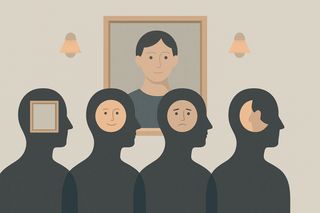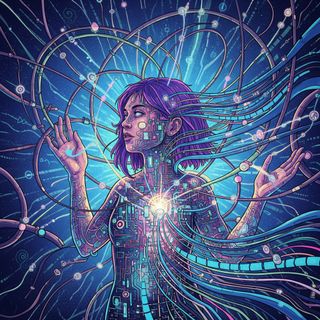Have you ever been in an argument with someone—a friend, a partner, a family member—where you feel like you're speaking different languages? You're both looking at the same set of facts, the same situation, but the conclusions you're drawing are from entirely different universes.
It's one of the most frustrating and profoundly human experiences. It's that moment you realize, with a jolt, that the person you're talking to isn't just disagreeing with you; they are living in a fundamentally different reality.
What if there were a mechanism that explains why our realities are so stubbornly unique?
The World Through a Survival Filter #
Before we can see the world, our brain has to make a choice. It's faced with an overwhelming flood of raw data—sights, sounds, feelings, memories. It can't possibly process it all. The sheer volume of information hitting your senses at any given moment is astronomically large, and the energy required to even attempt a full analysis would be biologically unsustainable. So, out of sheer necessity, the brain builds a filter.
This isn't a passive filter, like a coffee filter that just catches the big stuff. It's an active, intelligent system whose primary job isn't to see the world "as it is," but to build a version of the world that is useful for your survival. It constantly asks a few simple, brutal questions: "Is this a threat? Is this an opportunity? Is this useful for me right now?"
Consider a newborn infant. Its world is a chaotic swirl of light, sound, and sensation. It can't possibly make sense of it all. But its brain, wired for survival, builds a very simple filter. The world is reduced to a few critical signals: Warmth? Comfort? Milk? These are life-affirming opportunities. Loud noise? Hunger? Cold? These are immediate threats. Everything else—the color of the walls, the music playing in the background, the political news of the day—is just meaningless static. The infant's reality is a brutally simple, survival-first edit of the world.
You don't experience the world directly. You experience a highly personalized, heavily edited version of it.
As a person grows up, their experiences continuously shape their world processing filter. This highly personalized, heavily edited version of reality is what you experience every moment of your life. In this post, we call this filter the "Inside-Out Lens." It's a "lens" because it focuses, clarifies, and sometimes distorts. And it's "inside-out" because it is the lens that projects the outside world onto the metaphorical retina of your internal world.
What Are the Ingredients of Your Lens? #
So, where does your unique lens come from? It isn't a single thing; it's a composite, built from layers of influence that have been accumulating your entire life. Think of it like a stack of transparent, colored slides. Each one adds a new tint to your perception.
- The Hardware (Your Biology): This is the base layer. Your genetics, your unique brain chemistry, and the ancient survival instincts hard-wired into your nervous system. Are you naturally more cautious or more of a risk-taker? Your biological predispositions provide the initial settings for your lens.
- The Personal Scratches (Your Life Experience): Every significant event in your life leaves a scratch or a smudge on your lens. A single bad experience with a dog can permanently tint how you see every dog you encounter. A childhood where money was tight might mean your lens is forever primed to notice price tags and financial risk. Your triumphs, traumas, and formative memories all add to this deeply personal prescription.
- The Cultural Tint (Your Environment): You didn't build your lens from scratch. You inherited a base model from your culture. The language you speak shapes the very categories you think in. The social norms of your community define what is "normal" or "polite." This cultural tint is so pervasive that we often don't even notice it's there—it just feels like "the way things are."
- The Power Filters (Beliefs and Ideologies): This is the most powerful layer. These are the belief systems you consciously or unconsciously adopt. A political ideology, a religious framework, a scientific paradigm, or even an intense commitment to a brand or a cause. These systems act as powerful filters that organize the world for you, telling you what's good, what's evil, who to trust, and what to fight for. We have explored these deep integrations, the "Bio-Informational Complexes," in our previous post, but in short, they are called such because the belief system and the person become a single, co-dependent unit.
Your "Inside-Out Lens" is the sum total of all these layers. It's what makes you, you. And it's what makes every person you meet the main character of their own, entirely different first-person adventure game.
When Lenses Collide #
Now we can return to that frustrating argument from the beginning. The reason you feel like you're speaking different languages is because, in a way, you are. You are both describing realities that have been processed through entirely different lenses.
It's not that one person is "ignoring the facts." It's that their lens—shaped by a unique combination of biology, experience, and belief—is highlighting a completely different set of facts as important.
Imagine two people looking at a proposal for a new factory in their town.
- Person A's lens was forged in a family that struggled with unemployment. Their lens immediately filters the situation for opportunity. It highlights the words "jobs," "economic growth," and "stability." The potential for noise pollution or environmental impact is minimized—it's just static.
- Person B's lens was shaped by a love for nature and a childhood spent hiking in the local woods. Their lens filters the same proposal for a threat. It highlights "habitat destruction," "pollution," and "traffic." The promise of jobs is filtered out as a secondary concern.
Both are looking at the same proposal. Both are reacting rationally to the information their lens allows them to see. The argument isn't about the factory; it's a clash of lenses. Person A is debating economic survival, while Person B is debating ecological preservation. They are talking past each other because they are, quite literally, perceiving different problems.
We think we are arguing about the world, but we are actually arguing from within the invisible architecture of our own, personalized realities.
This is the core of so many of our intractable disagreements. We think we are arguing about the world, but we are actually arguing from within the invisible architecture of our own, personalized realities.
Beyond Diagnosis: A Practical Tool for Empathy #
It's easy to hear this and feel a little cynical, as if we're all just trapped inside our own programming. But the real power of understanding the "Inside-Out Lens" isn't just to diagnose our disagreements; it's to give us a powerful tool for connection.
It allows us to change the goal of a difficult conversation. Instead of trying to win—to prove that your reality is the "right" one—you can shift to a more curious and interesting goal: trying to understand.
True empathy isn't about agreeing. It's the difficult, imaginative work of trying to see the world through another person's lens, even for just a moment.
The next time you find yourself at an impasse, try asking a different set of questions, aimed at their lens instead of their logic:
- "When you look at this situation, what's the first thing that jumps out to you as most important?" (This helps you see what their lens is highlighting).
- "I can tell this is really important to you. What's your biggest concern here?" (This gets at the stakes and the "threat filter" of their lens).
- "Are we trying to solve the same problem here? It seems like you're focused on [the threat they see], while I'm focused on [the opportunity you see]." (This validates that you're both reacting to different perceived realities.)
This approach doesn't guarantee agreement. But it transforms a battle into a mutual exploration. It replaces the frustration of "Why can't you see it my way?" with the genuine curiosity of "Can you help me understand how you see it?"
Conclusion: Living in a World of Lenses #
The world isn't populated by billions of people who see the same thing and just disagree about it. It's populated by billions of people living in billions of unique, overlapping realities, each generated by a personalized "Inside-Out Lens" built for survival.
Recognizing this doesn't solve all our problems. But it gives us a place to start. It reminds us that every person we meet is the protagonist in their own story, seeing the world through a lens we can't see, but can, with a little effort, try to understand.



